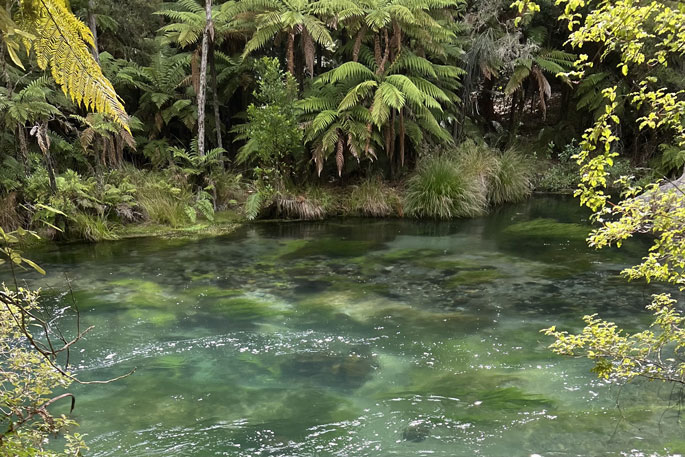It took half an hour of bumping up and down a gravel forestry road near Kawerau to end up at the Tarawera Falls carpark.
Although most of the drive was spent wondering if we were indeed heading in the right direction, the vast amount of scenery was enough to distract us from our phones which searched with no avail for reception.
Small little roads branch off the main track towards the falls, and pines in all stages of growth line the gravel road. If you're blessed to arrive at the falls on a quiet day, it's easy to believe you are completely cut off from the rest of the world.
After the vibrations that made their way into my bones from the bumpy trip subsided, we set off with our ‘healthy' lunch of pea snaps and biscuits to go and see what this place had to offer.
The walk was shorter than expected and sheltered from the sun by a thick blanket of native bush.
The path, littered with damp foliage, attracted the friendly Pīwakawaka, tui as we made our way upstream.
Walking alongside the Tarawera River is breathtaking. It's hard to imagine a place so untouched yet so incredibly beautiful.
There is a very fine line between wanting to share the natural beauty of a place with anyone who will listen, and keeping the beauty and stillness of it all to yourself.
After mentally noting the banks we'd come back to, to enter the clear waters, we completed the 15-odd minute walk to the viewing area where you can fully appreciate the falls in all their splendour.
A volcanic history
Power is the first thought that comes to mind when standing under the spectacular Tarawera Falls.
Water surges out of fissures in the large rock cliff-face surrounded by native bush. The cliff is said to be the end of an ancient rhyolitic lava flow, believed to have poured from an erupting Mt Tarawera about 11,000 years ago.
The abrupt stop to the flow is known to be what produced the high cliffs that surround the pooling water at the bottom of the falls.

The Tarawera river is visible for most of the walk to the falls. Photo: Jordan Boyd.
The flora, which has developed in the area since the 1886 Tarawera eruption, is rich in both pohutukawa and rata. Their appearances alongside the volcanic rock and flowing water is striking and makes the size of cliff faces even more impressive.
Photographs cannot do this scene justice. It's the loudness, the moisture on your skin and the realisation of how small you are in the scale of things that really make you aware of how powerful places like this are.
After a little exploring, a dunk into one of the slower-flowing rock pools and a quick snack, we back-tracked to return to the certain spot that caught our eye.
Lone pohutukawa tree
A lone pohutukawa tree that leans out over the turquoise waters became the perfect spot for us to sit and listen to the quiet sounds of the bush, a contrast to the deafening roar of the falls. The pohutukawa tree was also a great spot to leap into the fresh waters below and float downstream.
Soon it was time to head back to the carpark. However if we had been more time efficient, the tramping track to the Tarawera Outlet – about another two hours one way – would have been a very favourable option.
One thing to remember before heading into the forestry grounds is you need to gain a permit to access the Tarawera Falls and Tarawera Outlet.
You can order permits online in advance from Māori Investments Limited or from the Kawerau i-SITE Visitor Information Centre.
If you choose to visit Tarawera Falls, remember to take only photos and leave only footprints – although you may accidentally take a thick layer of dust back on your vehicle, but it's very much worth it.



0 comments
Leave a Comment
You must be logged in to make a comment.